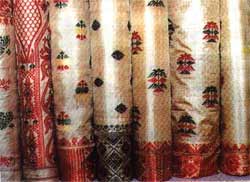Textile sector to attract Rs155,000 crore investment, create 10 million jobs
01 Jun 2009
The new government plans to attract investments worth Rss155,000 crore in the textile sector and transform the emerging sector into a developed industry, capable of providing over 10 million jobs across the country, union minister of textiles Dayanidhi Maran said today.
 Speaking to media persons after assuming charge, Maran said the government will impart momentum to this $52 billion industry ($21 billion exports and $31 billion domestic market) by striving to achieve a growth rate of 8 to 10 per cent per annum.
Speaking to media persons after assuming charge, Maran said the government will impart momentum to this $52 billion industry ($21 billion exports and $31 billion domestic market) by striving to achieve a growth rate of 8 to 10 per cent per annum.
Listing out the thrust areas, the minister said that the new government in the coming years will focus on achieving the following major targets in textiles sector:
- Create around 10 billion employment opportunities;
- Build world-class, state-of-the-art, manufacturing capacities; and achieving a dominant global standing in the manufacture and export of textiles and clothing;
- Equip the textiles industry to withstand the pressures of import penetration, and maintain its dominance in the growing domestic market;
- Enable small and medium enterprises (SMEs) to achieve competitiveness and enable them to face the global scenario with confidence; and
- Give emphasis for setting up new centres of National Institute of Fashion Technology (NIFT) in proximity to traditional textiles regions.
He said the new government will design a multi-disciplinary strategy to meet the above objectives. This would involve:
a) Consolidating the raw material base through the vigorous implementation of the Technology Mission on Cotton (TMC), Jute Technology Mission (JTM), Integrated Wool Improvement & Development Programme (IWIDP), and the Catalytic Development Programme (CDP).
b) Continue with modernisation and the technological upgradation of different segments of the textile industry through the Technology Upgradation Fund Scheme (TUFS).
c) Create a textiles-specific infrastructure by establishing Integrated Textiles Parks.
d) Continue with and stabilise the process of fiscal reform, thereby encouraging fresh export and private investment in the sector.
e) Accelerate the process of leveraging the assets of PSEs to fund already approved rehabilitation schemes.
f) Review and revamp the schemes being implemented for the welfare of handloom workers and handicraft artisans, and substantially increase the allocation in the union budget.
g) Initiate measures to attract foreign direct investment (FDI), particularly in the textiles machinery and in garmenting, synthetic and technical textiles segments.
He said the ministry is in touch with the organising committee of the Commonwealth Games to ensure concerted and meaningful representation of Indian handlooms and handicrafts.
This, he said, will be achieved through live demonstrations by artisans, setting up of `Shilp Bazaars' at the games venues, apparel designing for athletes and support staff by National Institute of Fashion Technology (NIFT), and supply of gift memento and souvenir.
Maran said the new government will tackle the issues of employment generation and maximise the welfare of stakeholders in the textiles industry such as weavers, cotton farmers, jute farmers, cocoon rearers, shepherds, mill workers, powerloom workers, artisans, traders, designers and exporters.






























